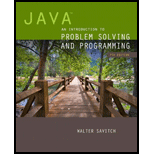
Concept explainers
Write a grading
- Two quizzes, each graded on the basis of 10 points, are given.
- One midterm exam and one final exam, each graded on the basis of 100 points, are given.
- The final exam counts for 50 percent of the grade, the midterm counts for 25 percent, and the two quizzes together count for a total of 25 percent. (Do not forget to normalize the quiz scores. They should be converted to percentages before they are averaged in.)
Any grade of 90 percent or more is an A, any grade between 80 and 89 percent is a B, any grade between 70 and 79 percent is a C, any grade between 60 and 69 percent is a D, and any grade below 60 percent is an F.
The program should read in the student’s scores and display the student’s record, which consists of two quiz scores, two exam scores, the student’s total score for the entire course, and the final letter grade. The total score is a number in the range 0 to 100, which represents the weighted average of the student’s work.
Define and use a class for the student record. The class have instance variable for the quizzes, midterm, final, total score for the course, and final letter grade. The class should have methods to compute the overall numeric grade and the final letter grade. These last two methods will be void methods that set the appropriate instance variables. Remember, one method can call another method. If you prefer, you can define a single method that sets both the overall numeric score and the final letter grade, bet if you do this, use a helping method. Your program should use all the methods described here. Your class should have a reasonable set of accessor and mutator methods, whether or not your program uses them. You may add other methods if you wish.
Want to see the full answer?
Check out a sample textbook solution
Chapter 5 Solutions
Java: An Introduction to Problem Solving and Programming (7th Edition)
Additional Engineering Textbook Solutions
Starting Out with Java: From Control Structures through Objects (7th Edition) (What's New in Computer Science)
Electric Circuits. (11th Edition)
Modern Database Management
Web Development and Design Foundations with HTML5 (8th Edition)
Starting Out With Visual Basic (8th Edition)
Starting Out with Programming Logic and Design (5th Edition) (What's New in Computer Science)
- 4. def modify_data(x, my_list): X = X + 1 my_list.append(x) print(f"Inside the function: x = {x}, my_list = {my_list}") num = 5 numbers = [1, 2, 3] modify_data(num, numbers) print(f"Outside the function: num = {num}, my_list = {numbers}") Classe Classe that lin Thus, A pro is ref inter Ever dict The The output: Inside the function:? Outside the function:?arrow_forwardpython Tasks 5 • Task 1: Building a Library Management system. Write a Book class and a function to filter books by publication year. • Task 2: Create a Person class with name and age attributes, and calculate the average age of a list of people Task 3: Building a Movie Collection system. Each movie has a title, a genre, and a rating. Write a function to filter movies based on a minimum rating. ⚫ Task 4: Find Young Animals. Create an Animal class with name, species, and age attributes, and track the animals' ages to know which ones are still young. • Task 5(homework): In a store's inventory system, you want to apply discounts to products and filter those with prices above a specified amount. 27/04/1446arrow_forwardOf the five primary components of an information system (hardware, software, data, people, process), which do you think is the most important to the success of a business organization? Part A - Define each primary component of the information system. Part B - Include your perspective on why your selection is most important. Part C - Provide an example from your personal experience to support your answer.arrow_forward
- Management Information Systemsarrow_forwardQ2/find the transfer function C/R for the system shown in the figure Re དarrow_forwardPlease original work select a topic related to architectures or infrastructures (Data Lakehouse Architecture). Discussing how you would implement your chosen topic in a data warehouse project Please cite in text references and add weblinksarrow_forward
- Please original work What topic would be related to architectures or infrastructures. How you would implement your chosen topic in a data warehouse project. Please cite in text references and add weblinksarrow_forwardWhat is cloud computing and why do we use it? Give one of your friends with your answer.arrow_forwardWhat are triggers and how do you invoke them on demand? Give one reference with your answer.arrow_forward
 C++ Programming: From Problem Analysis to Program...Computer ScienceISBN:9781337102087Author:D. S. MalikPublisher:Cengage Learning
C++ Programming: From Problem Analysis to Program...Computer ScienceISBN:9781337102087Author:D. S. MalikPublisher:Cengage Learning C++ for Engineers and ScientistsComputer ScienceISBN:9781133187844Author:Bronson, Gary J.Publisher:Course Technology Ptr
C++ for Engineers and ScientistsComputer ScienceISBN:9781133187844Author:Bronson, Gary J.Publisher:Course Technology Ptr

